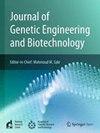Unveiling the molecular activity of HIV towards the CD4: A study based on subtype C via docking and dynamics approach
IF 3.5
Q3 Biochemistry, Genetics and Molecular Biology
Journal of Genetic Engineering and Biotechnology
Pub Date : 2025-01-16
DOI:10.1016/j.jgeb.2025.100457
引用次数: 0
Abstract
Background
Acquired Immunodeficiency Syndrome (AIDS) is a critical global health issue caused by the human immunodeficiency virus (HIV). It has different strains and subtypes; among these, Subtype C accounts for higher infection rates than others. Despite its high prevalence, the molecular interactions with host receptors, specifically CD4, have not yet been explored.
Methods
This study investigates the molecular interactions between HIV subtype C and the CD4 receptor via docking and dynamics approach. Four HIV targets were examined, and their structure was modelled. Subsequently, these models were docked with the CD4 to analyze their binding interaction. The stability was examined over 200 simulations via Desmond software, and trajectories were analyzed, followed by Root mean square deviation (RMSD), root mean square fluctuation (RMSF), and the radius of gyration (Rg), PCA (principal component analysis), etc., to assess their stability and interaction dynamics.
Results
The four target structures were modelled, and their quality was validated. Further, the docking analysis with CD4 revealed that the Envelope glycoprotein has −13.6 kcal/mol, protease has −11.2 kcal/mol, Reverse transcriptase has −12.4 kcal/mol, and integrase has −13.1 kcal/mol binding affinity towards it, followed by the number of hydrogen bond, such as 9, 6, 11, 6. The simulation over 200 ns demonstrated that the average RMSD for each complex started stabilizing within the 0.9 Å − 3.4 Å, followed by 25–50 ns, whereas the RMSF, Rg and PCA revealed the relative compactness and flexibility varied across different viral targets.
Conclusions
The study successfully identified the interactive residues of HIV subtype C toward the CD4 receptor. The binding affinities and stability data provide valuable insights into Subtype C’s molecular interactions with the host, and these findings underscore the potential for developing treatments that disrupt these interactions to combat HIV more effectively.

揭示HIV对CD4的分子活性:基于对接和动力学方法的C亚型研究
获得性免疫缺陷综合征(AIDS)是由人类免疫缺陷病毒(HIV)引起的严重的全球健康问题。它有不同的菌株和亚型;其中,C亚型的感染率高于其他亚型。尽管其发病率很高,但与宿主受体,特别是CD4的分子相互作用尚未被探索。方法通过对接和动力学方法研究HIV C亚型与CD4受体的分子相互作用。研究人员检查了四个HIV靶点,并对它们的结构进行了建模。随后,将这些模型与CD4对接,分析它们的结合相互作用。通过Desmond软件测试了200多个模拟的稳定性,并对轨迹进行了分析,随后进行了均方根偏差(RMSD)、均方根波动(RMSF)、旋转半径(Rg)、主成分分析(PCA)等,以评估它们的稳定性和相互作用动力学。结果建立了四种靶结构的模型,并对其质量进行了验证。此外,与CD4的对接分析显示,包膜糖蛋白的结合亲和力为−13.6 kcal/mol,蛋白酶的结合亲和力为−11.2 kcal/mol,逆转录酶的结合亲和力为−12.4 kcal/mol,整合酶的结合亲和力为−13.1 kcal/mol,其次是氢键数,如9、6、11、6。超过200 ns的模拟表明,每个复合物的平均RMSD在0.9 Å−3.4 Å内开始稳定,然后是25-50 ns,而RMSF, Rg和PCA显示了不同病毒靶点的相对紧凑性和灵活性。结论本研究成功鉴定了HIV C亚型对CD4受体的相互作用残基。结合亲和力和稳定性数据为亚型C与宿主的分子相互作用提供了有价值的见解,这些发现强调了开发破坏这些相互作用的治疗方法以更有效地对抗艾滋病毒的潜力。
本文章由计算机程序翻译,如有差异,请以英文原文为准。
求助全文
约1分钟内获得全文
求助全文
来源期刊

Journal of Genetic Engineering and Biotechnology
Biochemistry, Genetics and Molecular Biology-Biotechnology
CiteScore
5.70
自引率
5.70%
发文量
159
审稿时长
16 weeks
期刊介绍:
Journal of genetic engineering and biotechnology is devoted to rapid publication of full-length research papers that leads to significant contribution in advancing knowledge in genetic engineering and biotechnology and provide novel perspectives in this research area. JGEB includes all major themes related to genetic engineering and recombinant DNA. The area of interest of JGEB includes but not restricted to: •Plant genetics •Animal genetics •Bacterial enzymes •Agricultural Biotechnology, •Biochemistry, •Biophysics, •Bioinformatics, •Environmental Biotechnology, •Industrial Biotechnology, •Microbial biotechnology, •Medical Biotechnology, •Bioenergy, Biosafety, •Biosecurity, •Bioethics, •GMOS, •Genomic, •Proteomic JGEB accepts
 求助内容:
求助内容: 应助结果提醒方式:
应助结果提醒方式:


